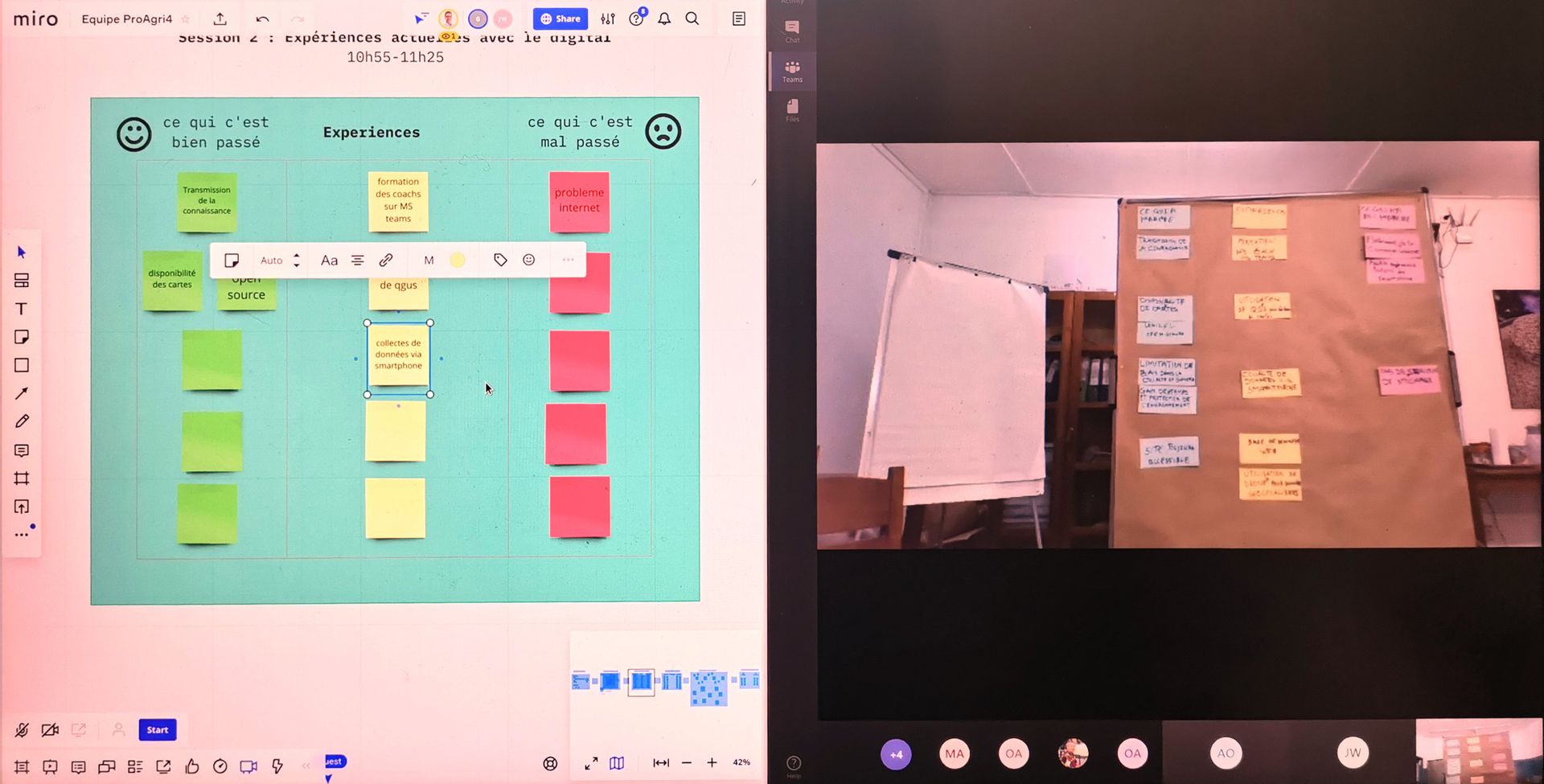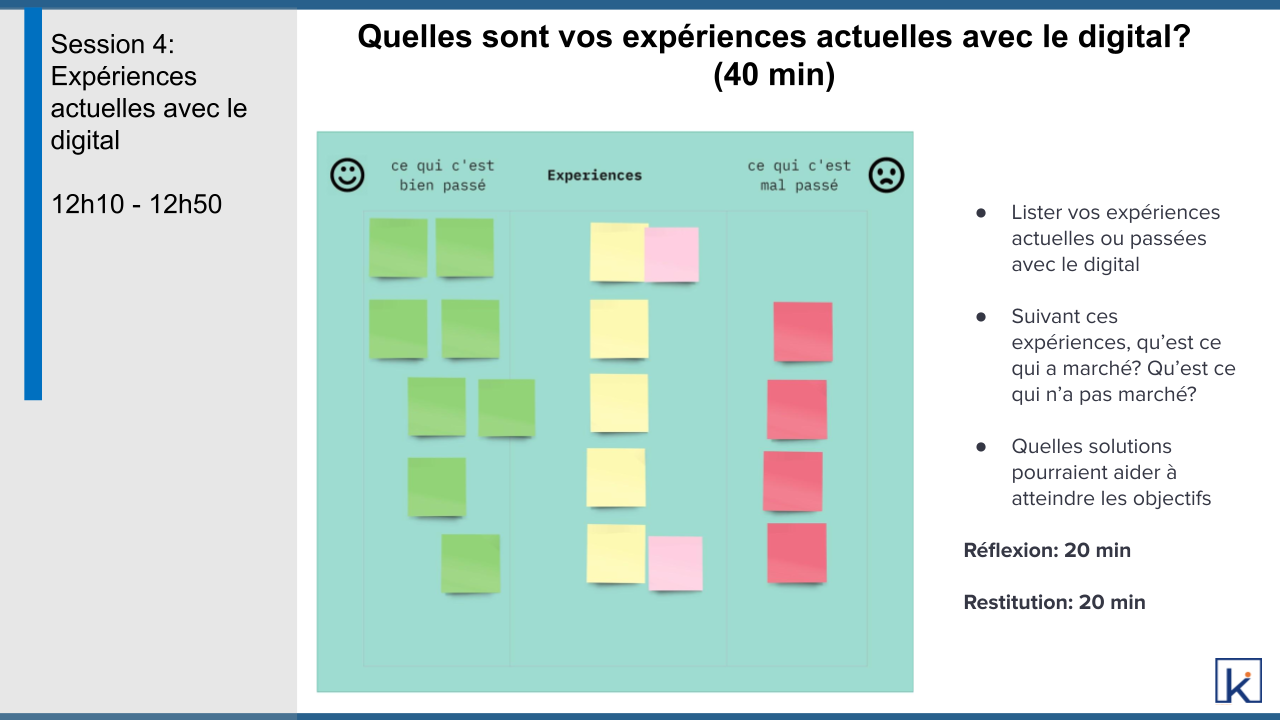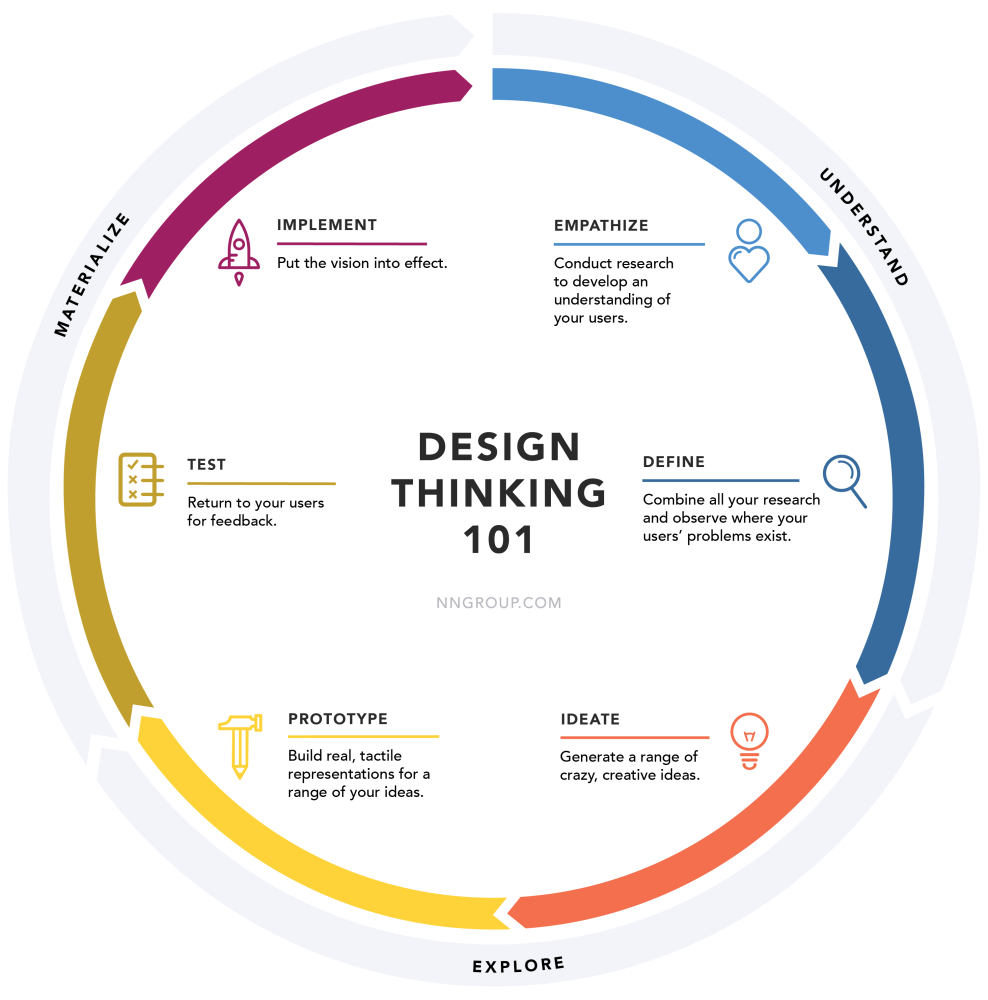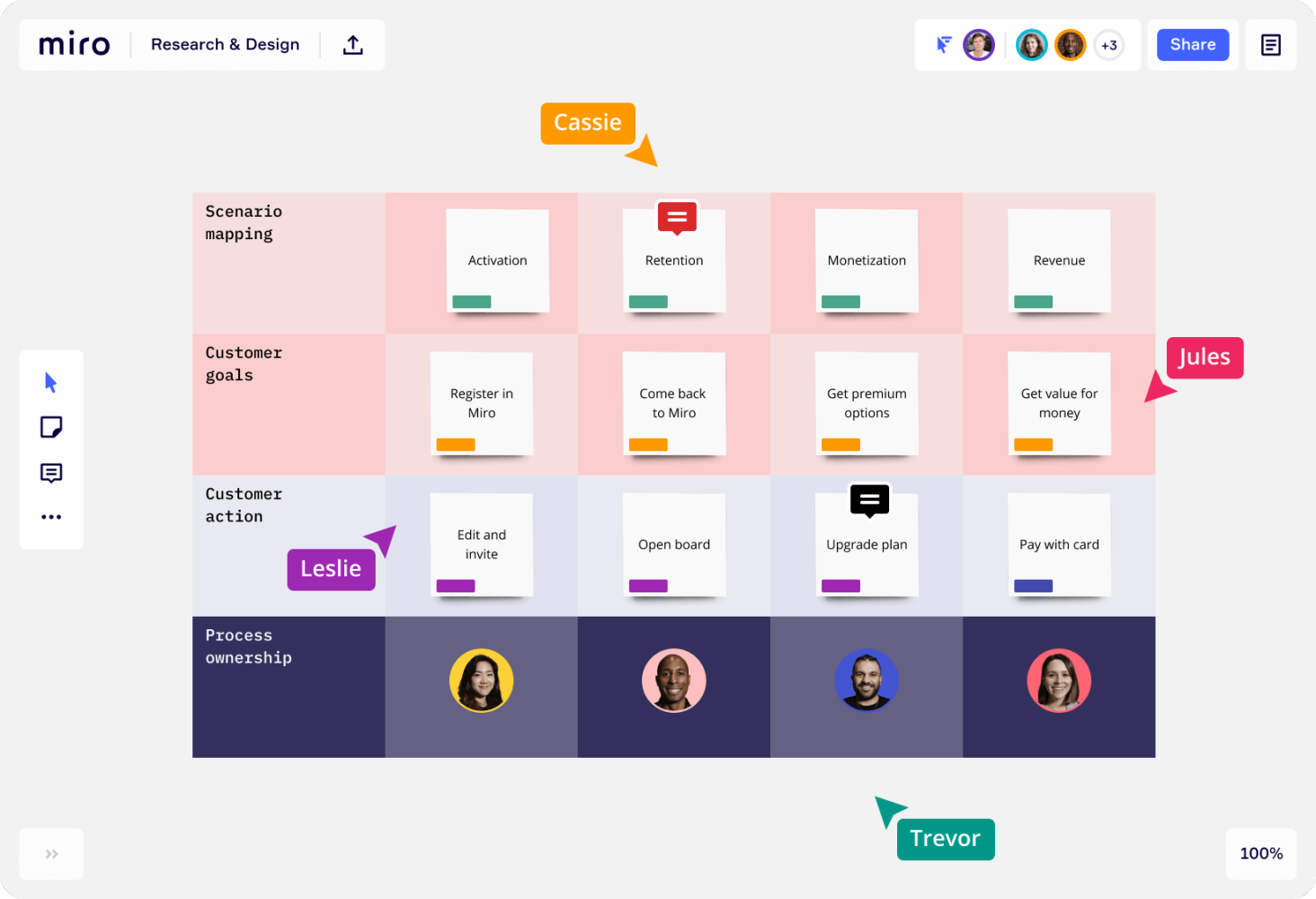Background
Last year, our team was asked to develop a digital program in the field of agriculture in Benin. Due to travel constraints related to COVID-19, we decided with our client not to take any risks and to carry out the mission remotely. Like many other organizations, we had to adapt and develop new ways to design and manage co-creation and co-design missions remotely in order to ensure the productivity of the company.
Traditionally, program design in international development requires scoping trips with intense travel itineraries, which not only bears financial costs, generates significant CO2 amounts and thus contributes to the climate crisis. Additionally, the high costs and overhead of travel missions pushes for short stays which can negatively affect the quality of research and create missed opportunities.
One of the few benefits of the pandemic is an opportunity to develop online and remote program design methods. However, the loss of face-to-face interaction and the dependence on digital tools and prerequisites - such as stable connections - brings difficulties. This article is a sharing of experience and we hope that the lessons learned can be useful for others in and outside of our sector.
Inspiration from Design thinking and User Centered Design
Design Thinking is a method that provides you with a solution-based approach that allows you to solve problems. It allows to tackle complex problems, by understanding the human needs involved, reframing the problem in human-centred ways, brainstorming a wide variety of relevant ideas, and adopting a hands-on approach in creating and testing your minimum viable product or prototype. While it originated in the product design world, it has been picked up by actors within the social impact and international development space.
User Centered Design (UCD) puts the end user at the center of the design process, and is also materialized in the digital development principle "Design with the User". As our goal is to insure impact, this is especially important as increased specialization in international development and the structure of funding approved and monitored at headquarters can create distance from the field - but this is a discussion for another post!
Adapting to collaborative program design
We are pragmatic with the methodology and use it for inspiration. In summary, we can describe the following phases:
- Understanding the context - i.e. who are actors in the space (stakeholder analysis)? What are opportunities and challenges (SWOT)? How did previous experiences with digital technologies unfold?
- Ideation - Develop ideas for possible program options.
- Prioritize ideas, for example according to complexity / feasibility / costs / timeline / impact etc.
- Refine and specify candidates further (budget, team, possible partners etc)
Consultation happens at every step. Testing in the classical design thinking sense is difficult to apply to program design, but it is possible to include prototyping of ideas in the ideation process and to present those to members of the program design consultations to achieve an iterative process.
Capturing collaborative creativity with Miro
Miro is a collaborative and visual remote platform and features a whiteboard that can be used for all kinds of purposes (brainstorming, SWOT analysis, prioritization and categorization, etc.). Mural is another popular alternative.
In our work, we mainly see three ways of using these tools:
Option 1 - Miro as a template for physical whiteboards
If conditions do not allow all participants to use the Miro tool (due to bad connectivity or lack of electricity, a very bright room), it is possible to use Miro as a model for on-site facilitators to recreate the exercises on-site. In this case, participants document using the traditional paper tools (cards, markers). Remote facilitators can capture information during reporting phases. On-site facilitators can also take pictures of the final results, which can be digitized if necessary.

Option 2 - Miro as documentation space (blended)
It is also possible to use Miro as a live documentation of the results of the exercises. Advisors/facilitators are connected to Miro and enter the information collected or explained orally by participants - although paper might still be used for participants to organize their thoughts. This allows the participants to follow the documentation and to make clarifications, for example if a point is not correctly recorded.
Option 3 - Miro as collaborative whiteboard for all participants
It is also possible to provide access for all participants, allowing for 100% remote virtual workshops with participants in different locations.. Of course, this is only possible if they have adequate skills, equipment and connectivity.
10 Lessons Learned
Here are the insights that we would like to share from our experience:
1. Understand your constraints (connectivity, equipment, skills)
Facilitating a workshop via an online collaborative tool requires that connectivity aspects be taken into account. It should be noted that by using a collaborative tool such as Miro, it is possible to avoid screen sharing which can be difficult for sites with poor connectivity (connecting to the Miro board uses less bandwidth than screen sharing). Participant’s level of digital literacy will influence their ability to effectively participate, so be aware of the skill's limitations and the bias it may introduce! The best way to understand it is to do a quick pre-meeting and test the tools you want to use.
2. Include end users in the design process
We are often surprised that we still need to emphasize this in our work. Call it Human Centered Design, the “design with the user” principle - including end users in the design process is key to designing for impact. If it is not possible to include end users - at the very least include tools that allow consideration of their perspective, for example, by developing persona exercises for the different end users.
3. Adapt the schedule to remote and virtual work
When you are doing in-person workshops, it is much easier to get the team together after the workday for preparation / debrief / discuss ideas and synthesize. It is also easier to collect additional information. Therefore the timeline of a virtual mission will often be longer than a face-to-face mission. While this may be perceived as a disadvantage - this can also allow more time for review, and less participants and team fatigue.
4. Use pictures and other media to immerse yourself and participants
It’s easy to lose an understanding of context in a remote work environment. In order to counter this, you can ask participants to share pictures with you ahead of a workshop. Another alternative is to ask every participant to introduce themselves with a specific video background of their typical work environment. It works great as a warm up exercise, too!
5. Include clear exercise instructions

We recommend that the instructions for each exercise be included on the materials, and usually present a slide with the goal, steps and timing of each exercise. It is also useful to include any information to form groups if required. It's also important to give context to the overall mission and how an exercise relates to it - nothing worse than participants not knowing why they are being asked to do something.
6. Focus on simple exercises
The simplicity of the exercises maximizes participation and also facilitates documentation. Especially when we first started using the tools, we made the exercises way too ambitious! The flexibility of tools like Miro always allows for adding information later - for example after a quick 1:1 to dig deeper - so we recommend to start simple and evolve as needed.
7. Be realistic about time
The remote workshop requires that you map out the time for each activity and stick to it. Therefore, it is important to plan to avoid running out of time or having unfinished exercises due to lack of time. Also, ensure to include breaks and incite people to truly take them - it’s very easy to get distracted by your inbox or other urgent tasks.
8. Have an on-site facilitator as ally
Having an ally on-site allows you to take the temperature of the room, to know if there are concerns about understanding or if participants' attention is decreasing and if a break or repeating instructions is needed. Ideally your ally should be aware of the scheduled exercises. In our case, our client nominated a dynamic team member who even learned Miro throughout the process and helped with documenting!
9. Debrief after the workshops!
Even a quick debrief session allows for the collection of positive/negative points to improve the following sessions, and empowers your facilitators to take ownership. Every group has different dynamics, and agility is key! It’s harder to gauge the success of a remote workshop, so make sure to include a quick evaluation.
10. Review inputs shortly after the exchanges
Ever had to go back and review notes from a workshop that took place several weeks ago? If possible, review the workshop notes directly after the discussion. Facilitators will be able to contribute missing elements with a fresh memory of the discussions. To facilitate documentation, it is possible to take pictures of post-its or the classic whiteboards used in the room, or even to use an audio recording in workshops with a lot of discussion.
Conclusion
For us, using a methodology inspired from design thinking and a collaborative tool like Miro demonstrated that it is entirely possible to carry out this type of scoping and program design project remotely by taking advantage of collaborative tools.
The key success factors for remote workshops are good preparation, effective collaboration with on-site allies and agility in the process. Creative processes can provide unexpected results or take a direction which was not foreseen by facilitators and client, so close communication and agility is important.
Of course, some elements cannot be replaced by virtual tools and total immersion, but by doing our best to mitigate the disadvantages we believe it will be possible to avoid many trips in the future, and thus have a positive impact on CO2 emissions and work-life balance.
What are your experiences running design workshops remotely? Do you agree with our recommendations? Please share your experiences!

